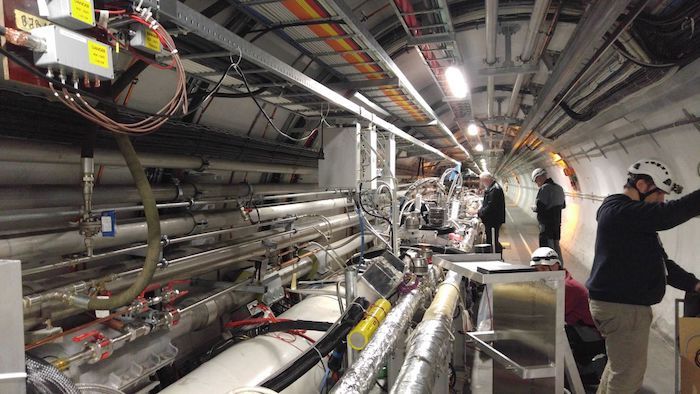
A team of more than 100 researchers working at the Large Hadron Collider in Europe may have just witnessed the first direct evidence of a theoretical particle called an odderon.
An odderon—in theory—is a subatomic quasiparticle, meaning something that behaves enough like a particle to be considered one. First theorized back in 1973, it has eluded observation by scientists working with particle accelerators, the instruments that smash atoms together at the speed of light so we can study the reactions. Its discovery would upend our understanding of how particles should behave according to the Standard Model of physics, and give us more insight into what governs their movements at light speed.
The LHC, the world's leading accelerator, belongs to the European Organization for Nuclear Research, better known as CERN. To get to odderons, CERN researchers start with hadrons, which is the umbrella term for subatomic particles like protons and neutrons. Each hadron is composed of a small cluster of quarks, which are held together (or glued, if you prefer) by gluons, according to a Kansas University press release.
Experiments in which researchers collide those particles in the LHC have only ever revealed evidence of protons exchanging pairs of gluons—so, only even numbers, according to Brookhaven National Laboratory. Now, by measuring a higher number of collisions at a higher energy, researchers have recorded the first observations of gluons reacting to the collisions by moving in groups of odd numbers (three or more). The research was compiled into two papers, one published at CERN and the other at the online study repository arXiv.
"The protons interact like two big semi-trucks that are transporting cars, the kind you see on the highway," Timothy Raben, a particle theorist at Kansas University who has worked on the odderon, said in the university press release. "If those trucks crashed together, after the crash you'd still have the trucks, but the cars would now be outside, no longer aboard the trucks—and also new cars are produced (energy is transformed into matter)."
Because of the understandably "convoluted" nature of the subject, as an experiment spokesperson put it to Gizmodo, these results are far from definitive. But aside from the excitement of potentially discovering something scientists have been chasing for decades, this kind of research with ultra-fast particle detectors could have implications for astrophysics (like measuring cosmic rays) and potentially medicine and even desalinating seawater, according to the university press release.
"This doesn't break the Standard Model, but there are very opaque regions of the Standard Model, and this work shines a light on one of those opaque regions," Raben said in the press release.
Uncommon Knowledge
Newsweek is committed to challenging conventional wisdom and finding connections in the search for common ground.
Newsweek is committed to challenging conventional wisdom and finding connections in the search for common ground.
About the writer
Kastalia Medrano is a Manhattan-based journalist whose writing has appeared at outlets like Pacific Standard, VICE, National Geographic, the Paris Review Daily, ... Read more
To read how Newsweek uses AI as a newsroom tool, Click here.








